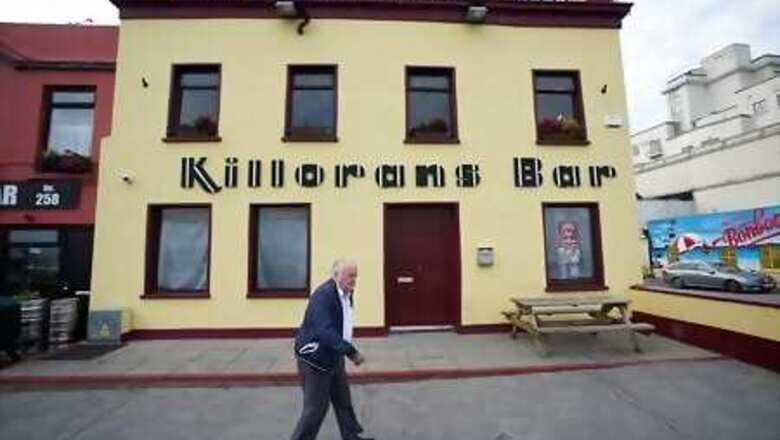
views
DONARD, Ireland: Ireland’s plan to reopen its economy at a slower pace than most was supposed to ensure a more sustainable rebound from the COVID-19 crisis. Tell that to pub owner Paul Moynihan.
Eagerly awaiting a promised July 20 reopening of non-food pubs, he spent 10,000 euros ($11,855) on a beer garden at his establishment in the village of Donard hoping some late summer trade would help compensate the sudden March closure.
But the government moved the date three times and those pubs are now only due to open their doors on Sept. 21 – even though infection rates are 10 times more than late July.
“It’s ironic: they kept us closed to make sure the numbers didn’t rise and they rose hugely with us closed,” said Moynihan, surrounded by empty stools at his bar in the small County Wicklow locality, 50 km (31 miles) from Dublin.
“I don’t know what the logic was, it didn’t work anyway.”
The antithesis to Sweden’s hands off approach, Ireland’s strict controls on labour-intensive sectors did keep coronavirus cases among the lowest in Europe. But a recent spike has seen the 14-day rate of cumulative cases per 100,000 people jump to almost 40 from three to four in late July.
As the only country in Europe with most pubs still shut – together with most live venues and all nightclubs – the ultra-cautious lockdown exit is bringing uneven recovery in the European Union’s best-performing economy for most of the last five years.
Unemployment, including those considered temporarily laid off, stands at 15.4%, while the government is subsidising the wages of a further 15% of the workforce.
However, Ireland’s large multinational sector has protected it, with data this week showing a far shallower recession than most in the second quarter, setting the economy on an uneven “K-shaped” trajectory, with some high-value export sectors thriving while domestic-facing consumer sectors suffer.
While Irish gross domestic product fell by just 3% year-on-year, the least bad in the EU, a 23% collapse in consumption was the second largest behind Spain.
“Ireland’s exports are set up sectorally pretty well for COVID. We do a lot of pharmaceuticals, a lot of medical devices and a lot of tech services, particularly cloud computing. That means we’re doing okay actually as a whole,” said Irish Business and Employers Confederation (IBEC) chief economist Gerard Brady.
“But if you look at any of the key metrics during lockdown, Ireland is towards the worst affected countries on almost all of them. The most employment-intensive sectors have suffered the worst.”
PATCHY RECOVERY
Ireland’s hospitality, retail, administrative and transport sectors account for half of the 220,000 people still temporarily laid off. By comparison, multinationals employed 245,000 or one-in-ten workers at the end of 2019.
Low activity in job-rich sectors, exacerbated by severe travel restrictions that halted virtually all inbound tourism, risks scarring effects such as long-term unemployment.
The patchiness of the recovery is widely evident.
DIY store owner Grafton felt obliged to repay the government for lockdown wage supports after consumers who had built up a record level of savings flocked to its outlets upon their May reopening.
Carrier Ryanair , on the other hand, is suing the state over travel curbs and has warned its Irish workers will be worst hit by job cuts. Building materials group Kingspan saw Irish revenues fall by 90% at the height of lockdown, three times the average rate across all 70 countries it operates in.
“In one of our businesses, we didn’t raise an invoice for two months, which is quite staggering for a large industrial business,” Kingspan Chief Executive Gene Murtagh told Reuters.
“Whether or not the country got the health dividend commensurate with those actions, I’d say is questionable.”
While escaping the kind of excess deaths suffered in Sweden, Spain and Britain, Ireland has had a broadly similar fatality rate to other EU economies that opened much faster, according to the European Centre for Disease Prevention and Control (ECDC). Relatively low hospital bed capacity explains the caution.
In Donard, home to farm workers and Dublin commuters but without a cafe, restaurant or public transport link, Moynihan is just glad he may see his regulars again.
“There are people in rural Ireland who won’t see anybody really without the pub,” said Moynihan, who as president-elect of the Vintners’ Federation of Ireland pushed the government for a firm opening date.
“It feels like there’s light at the end of the tunnel.”
(Editing by Andrew Cawthorne)
Disclaimer: This post has been auto-published from an agency feed without any modifications to the text and has not been reviewed by an editor














Comments
0 comment